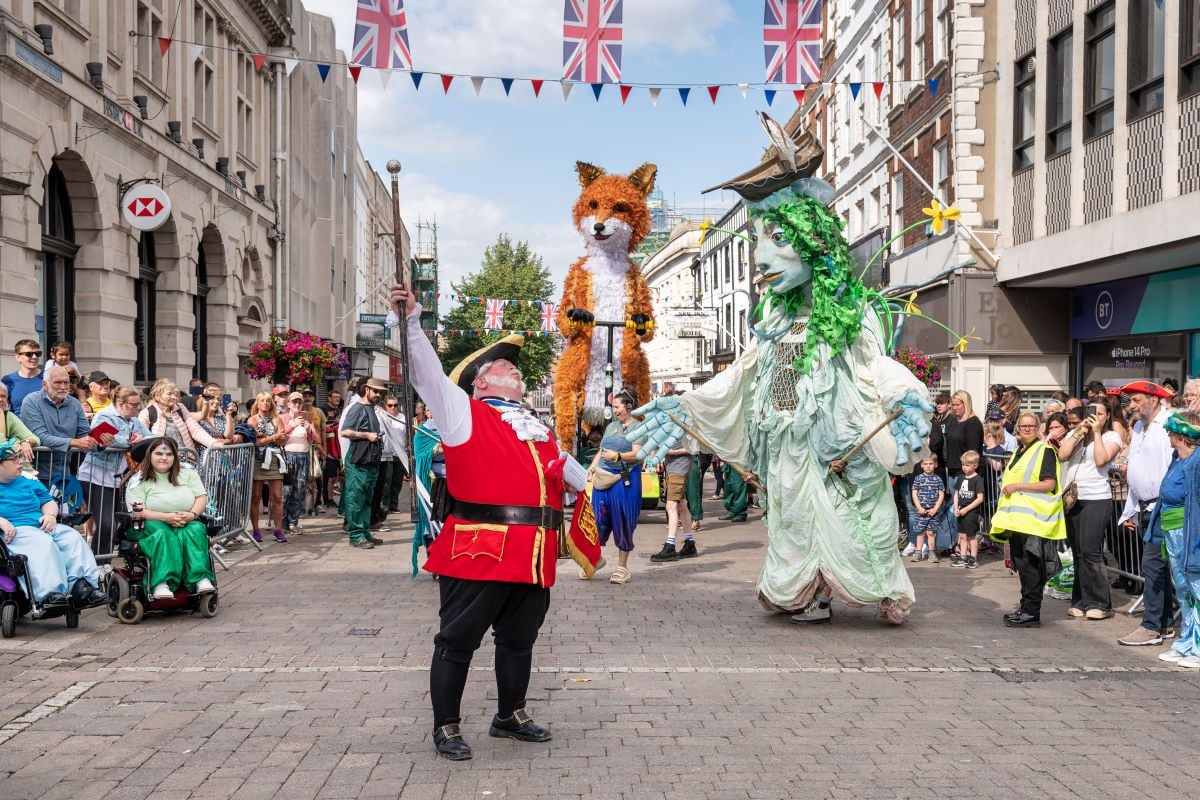
Street Fest in Gloucester
Photo: Historic England
High streets: The future is now
More than half of England’s high streets were built over a century ago, with buildings now falling into disrepair. Ellen Harrison shares how culture-led regeneration is changing them for the better.
High streets have always been meeting places, centres for community, conversation and commerce. Likewise, culture and heritage have always brought people together, to express identities, emotion and hope. It’s no wonder then that good things happen when you take the unique role culture plays in our society and put it on high streets, especially in places that need extra support.
Since 2020, Historic England has run the largest ever publicly funded and community-led arts and heritage cultural programme in England. Working with more than 60 high streets across England, it manages the £95m High Streets Heritage Action Zones regeneration scheme, working in places that need it the most.
With funding from central government and the National Lottery Heritage Fund, alongside advice and guidance from Arts Council England, we’ve distributed £7.4m to hundreds of arts organisations. By the end of the programme, we will have reached more than a million people through cultural programming on high streets.
From Wednesbury to Wakefield, Lincoln to Leicester, cultural organisations have co-created programmes with local people helping everyone re-discover, celebrate and shape the future of their high streets.
A glimpse of the future
The quality of the work has been extraordinary in celebrating local identity. A recent stand out was been Poet Laureate Simon Armitage’s ode to Eldon Street in Barnsley. He, and his band LYR, composed a set of songs unearthing both recent and new histories of the high street in glorious minutiae: “The queue of young girls in Miss Nails. This little piggy wears Samoan Sand, Cajun Pink, Big Apple Red.”
Always locally led, participative and rooted in place, the programme has had a remarkable impact so far. Emerging findings from audience surveys give us a glimpse of what high streets could become in the future.
Audiences are hyper-local, with the vast majority living within four miles, suggesting local communities are benefitting the most from the wellbeing outcomes of the programme. For example, 75% of audiences feel more part of their community after taking part in the cultural programme.
Perceptions and experiences of high streets and local areas have also improved: 87% of people feel more positive that the high street is a place where they can experience culture and arts; and 77% of people have a greater sense of pride in their high street and local area.
National commissions
We’re starting to see culture as a driver for people returning to high streets. 69% of audiences said the cultural activity was the main reason they visited their high street and 79% of audiences visited local shops, cafes and businesses before or after they attended a cultural programme activity.
When we ask people what would make them spend more time on their high streets, the top three choices are: cultural activities (gigs, performances, heritage trails, festivals); cultural places (museums, galleries); and independent shops. People not only welcome cultural activity on their high streets, they also expect these spaces to be lively and welcoming, offering experiences you can’t get elsewhere.
If we don’t use these historic buildings, they will fall into disrepair.
How else can culture help us rethink high streets? More than half of England’s high streets were built before 1918. If we don’t use these historic buildings, they will fall into disrepair, threatening the loss of important parts of our collective heritage.
In Middlesbrough, artist-led organisation Navigator North occupies a disused pub on the high street which has become a centre for community exhibitions, events and creativity. On the Isle of Wight, Shademakers – one of the leading carnival groups in Europe – has taken up residence in a landmark department store in Ryde, that’s being transformed into an arts and cultural space for the whole community.
The cultural programme also includes a series of national commissions directly delivered by Historic England in partnership with some of the best arts organisations in the UK, all working with co-creative principles. In the final year of the programme, we’re delivering two landmark projects that celebrate high streets.
Centres of creativity
The first is Picturing High Streets, a nationwide photography exhibition of images taken by the public produced in partnership with Photoworks. You can see the touring exhibition throughout the summer, on high streets of course.
The second is Hi! Street Fest. Delivered by Emergency Exit Arts, Farrah the Fox – a giant 5-metre high mechanical puppet on a scooter – travels across England discovering what makes high streets so special. When we opened First Light Festival in Lowestoft with Hi! Street Fest, the streets were lined with thousands of people: another testament to the power of culture in bringing people together.
As the programme comes to an end, there is almost universal agreement the development of culture on high streets should not end here. One of its legacies will be in the local partnerships forged through this work and now is the time to sustain those partnerships throughout the sector.
More meaningful and longer-term access to meanwhile space for arts and culture practitioners is another important aspect in regenerating high streets, alongside high-quality participative programming for all that gets people back into town centres.
With continued investment, collaboration and innovative thinking, culture can transform high streets. Together, we can develop a future where people visit high streets to not only shop and eat out, but also experience new centres of creativity in accessible, inclusive and joyful ways.
Ellen Harrison is Head of Creative Programmes at Historic England.
![]() historicengland.org.uk/
historicengland.org.uk/
![]() @HistoricEngland | @_Ellen_Harrison
@HistoricEngland | @_Ellen_Harrison
For more information on the High Street Cultural Programme visit: historicengland.org.uk/highstreetculture.
Join the Discussion
You must be logged in to post a comment.